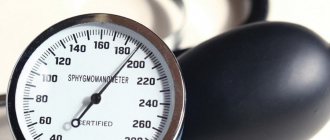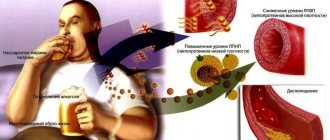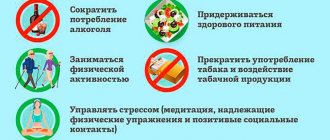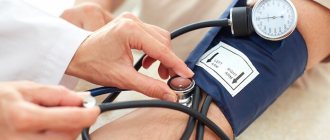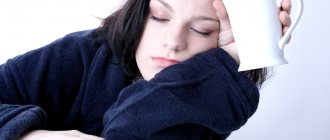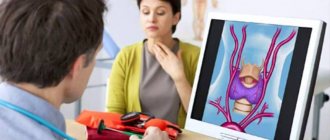Blood pressure (BP) is a vital indicator that characterizes the state of the cardiovascular system. A pressure of 140 over 70 means a slight increase in the systolic reading and a decrease in the diastolic reading. The danger is the high difference between the upper and lower parameters. The normal value should not exceed 30-50 mmHg.
Are these normal indicators?
Blood pressure is a dynamic indicator that changes under the influence of external and internal factors - stress, pathologies of internal organs, “white coat” syndrome, age, etc. To make a diagnosis, it is necessary to monitor pressure at different times of the day, then, based on systematic measurements, one can conclude whether the change in indicators is normal or pathological.
An increase in pulse pressure indicates a high load on the heart during myocardial contraction. This indicator is a variant of the norm for some athletes due to the increased load on the cardiovascular system.
What to do if the reading is 140/70 mm Hg. Art. – general recommendations:
- If such numbers appear on the tonometer only once and other blood pressure measurements during the day do not exceed the norm, there is no reason to worry. The patient was probably nervous or there was a measurement error.
- Systematic excess of blood pressure throughout the day is a reason to contact a medical institution. This condition may indicate diseases of the internal organs, primarily the endocrine system.
In order for the parameter value to be as accurate as possible, blood pressure must be measured on an empty stomach and the patient must be at rest.
Features in patients of different age groups
Pulse hypertension is typical for patients of different age groups. In order to take timely measures, you need to understand what this means and whether this pathology is dangerous for the body.
In children and adolescents
At a young age, pathology may indicate the initial stages of hypertension. The pulse difference changes due to stress, physical and emotional stress.
In older people
With age, the elasticity of blood vessels is lost and the heart muscle wears out. Changes in blood pressure in older people are possible evidence of vascular atherosclerosis, pathologies of the heart, liver and kidneys.
In pregnant women
During pregnancy, a woman’s internal organs experience increased stress, which is the reason for changes in blood pressure.
Pathology is indicated when the difference is over 50 mmHg. Art. is observed constantly and is accompanied by a deterioration in the general condition of the expectant mother. Chronic changes in blood pressure levels lead to disruption of the uteroplacental circulation, which in turn leads to pathologies of fetal development.
What does it mean if the pressure is 140 to 60 mmHg? st
Blood pressure 140/60 indicates an increase in systolic blood pressure and a moderate decrease in diastolic blood pressure. In addition, there is a high pulse difference.
Systolic blood pressure indicators depend on the following factors:
- Myocardial contractility.
- Heart rate.
- Elasticity of the walls of blood vessels.
Diastolic blood pressure is a criterion for assessing the degree of resistance of small blood vessels. In addition, changes in circulating blood volume can also affect this indicator.
An increase in systolic blood pressure can be observed in various pathologies, but most often it is associated with the following processes:
- greater force of contraction of the heart muscle (in such a situation, most often the pressure is 140 to 60, 60 pulse);
- tachycardia;
- increased arterial tone;
- sclerotic changes in the walls of arteries;
- the presence of atherosclerotic plaques in the lumen of blood vessels.
A decrease in diastolic blood pressure is most often observed with a decrease in the elasticity of the vascular walls.
Classification of blood pressure levels
A blood pressure of 140 over 60 (in both the elderly and young) cannot be considered normal. It does not fit any of the normal criteria for assessing blood pressure:
- the systolic indicator exceeds the norm;
- diastolic - below normal;
- pulse pressure exceeds the maximum permissible value of 60 mm.
According to statistics, no more than 15% of the population over 60 years of age live with normal blood pressure. All others are diagnosed with high blood pressure. Even if a person has been hypotensive all his life, in old age he will suffer from hypertension.
What does a high pulse difference mean?
It is worth noting that with such diseases, blood pressure levels will be constant. If there is an increase in pressure from normal to such indicators, then this will most likely indicate hypertension.
With a large pulse difference and isolated systolic hypertension, there is a risk of stroke and myocardial infarction. In addition, there is insufficient blood supply to the kidneys in the periphery, and there is also a risk of dilation of the heart chambers.
Self-medication is strictly not recommended. What to do if the pressure is 140 over 60, only a doctor should decide.
If a person’s blood pressure is 140 over 60, then it is better to consult a local physician. As drugs that can be used independently, you can use:
- diuretics;
- Folic acid (normalizes heart function).
All other drugs are prescribed by a doctor depending on the cause of the disease.
Practical video tips will help you correctly measure blood pressure with a tonometer:
https://youtube.com/watch?v=9TYOUDiO20A
Causes and trigger factors
Pathology can be caused by external and internal factors. Internal causes include heart disease and chronic diseases.
Causes of increased pulse pressure:
- liver and kidney pathologies;
- increased intracranial pressure;
- diseases of the cardiovascular system.
- stress, nervous experiences;
- excess body weight, sudden weight loss;
Risk factors:
- persons over 40 years of age;
- genetic predisposition;
- sedentary lifestyle;
- bad habits;
- improper diet, constant dieting or fasting;
- increased mental and physical stress.
Causes of high pulse pressure
The level of pressure in most cases depends on age. Over time, a person’s organs, his heart and blood vessels age and “wear out,” which is the reason for the increase in blood pressure. Even for those who suffered from hypotension in their youth, after 50 years the pressure normalizes, and at an older age, in most cases, arterial hypertension develops.
A pulse pressure reading above 60, and in this case 80 units, is a sign of increased tone of the walls of large vessels, in particular the aorta. This difference is often observed in older people, as well as those suffering from coronary heart disease and those who have already suffered a heart attack or stroke. A number of other reasons include the following:
- nervous tension;
- heart failure;
- bad habits;
- hypertension;
- diabetes;
- tumors;
- endocrine disorders;
- malfunction of the thyroid gland;
- fasting, strict diet;
- physical or emotional fatigue;
- problems with the kidneys and/or adrenal glands;
- uncontrolled intake of junk food;
- excess salt in the diet;
- weight change;
- pregnancy (third trimester);
- lack of iron in the body.
All these reasons are a direct indicator for consultation with a cardiologist and a corresponding examination of the body.
Symptoms
Each person's body is individual. Some patients do not notice an increase in pressure, others note the presence of symptoms:
- headaches, dizziness;
- “flies” before the eyes;
- swelling;
- decreased visual acuity;
- apathy, lethargy;
- numbness of the limbs;
- irritability;
- decreased performance;
- sleep disturbance;
- increased heart rate.
How can it manifest itself? Associated symptoms
The severity of symptoms directly depends on the individual characteristics of a particular organism. Some people practically do not feel pressure fluctuations and discomfort, while others develop characteristic signs. The more pronounced the symptoms, the worse the impact of the indicators on health. Here is their full list:
- apathy;
- fatigue and increased fatigue;
- poor concentration;
- dizziness;
- severe headaches (mainly in the temporal and occipital regions);
- nosebleeds;
- facial redness;
- excessive sweating;
- “flies” before the eyes;
- memory problems;
- nausea, vomiting (bringing minor relief);
- deterioration of vision and hearing;
- weather sensitivity;
- knocking in the temples;
- drowsiness;
- increased heart rate;
- chills, cold sweat;
- disorientation in space;
- feeling of lack of air;
- fainting;
- numbness of the limbs.
The risk group includes athletes, expectant mothers (especially in the last trimester), and elderly people (over fifty years old). Also, all people whose professional activities involve heavy physical work.
It should be said that even if there are practically no symptoms, disorders can still have an extremely negative impact on the body. He will accumulate all his strength in order to adapt and normalize his condition, but over time he will get tired of fighting. The consequences in this case creep up unnoticed. For this reason, cases of heart attacks, strokes, and heart attacks among young people against the background of imaginary well-being have become more frequent.
Treatment methods
To correct blood pressure, complex treatment is carried out, which includes not only medications, but also traditional medicine methods. In addition, massage and moderate physical training will help prevent the appearance of painful symptoms.
Medicines
Drug therapy is prescribed exclusively by a doctor. At 140/70 mm Hg. Antihypertensive drugs must be selected very carefully to avoid a decrease in diastolic pressure.
| Pharmacological group | pharmachologic effect | Examples of drugs |
| ACE inhibitors | Lowering blood pressure, reducing peripheral vasoconstriction. | Captopril, Enalapril |
| Calcium antagonists | Inhibition of the penetration of calcium ions into the muscle cells of the heart and blood vessels | Verapamil, Cinnarizine |
| Antispasmodics | Relaxation of smooth muscles, relief of painful symptoms | Drotaverine, No-shpa |
| Diuretics | Increasing the rate of urine production, eliminating excess fluid in the body, preventing edema. | Hypothiazide, Spironolactone |
Information about medications is presented for informational purposes. Information about the treatment regimen and dosage will be provided by the attending physician.
Alternative medicine
The use of traditional medicine is possible after prior consultation with a doctor.
Popular recipes:
- Herbal decoction. To prepare the drink, you need dried plants: rose hips, motherwort, oregano, hawthorn, St. John's wort. Prepare a decoction from the ratio of 1 tbsp. raw materials for 1 tbsp. boiled water. Use 2 times a day before meals.
- Juices of fresh beets, cucumbers, carrots.
- Lotions using apple cider vinegar.
Traditional recipes are not used in cases of individual intolerance or allergic reactions to their components.
Massage
To improve peripheral blood flow, massage is recommended 1-2 times a day. The main techniques are patting, rubbing, stroking.
| Organ | Execution method | Number of times |
| Ears | Rubbing the ears | 20 |
| Eyes | Using a stroking motion, use the back of your bent thumbs to move along the eyebrows from the inner edge to the outer edge - from the bridge of the nose to the temples | 20 |
| Neck | Cross your hands at the back of your head, fingers locked. Raise your head, look up, tense your neck muscles and try to bend your neck with your arms | 3-9 |
| Stomach | Lying on your back, make circular movements around the navel clockwise and counterclockwise | 20-30 |
| Knees | Stroking movements clockwise and counterclockwise | 20-30 |
Massage is contraindicated in the presence of malignant tumors, osteomyelitis, and vascular thrombosis.
Exercises
Systematic exercise therapy and sports help normalize blood pressure. It is recommended to increase physical activity gradually. When performing exercises, it is necessary to monitor your general condition.
Popular exercises:
- Nordic walking.
- Diaphragmatic breathing - belly.
- Raising your legs while lying down.
- Squats. As you inhale, raise your arms up, and as you exhale, lift them down.
- Tension and relaxation of the gluteal muscles while sitting on the floor.
- Running without lifting your toes off the floor.
Yoga and breathing exercises will help normalize your condition.
Prevention
Preventive measures are recommended for patients of any age. Prevention of hypertension includes:
- Maintaining a healthy lifestyle: adequate work and rest, hardening, moderate physical activity, daily walks in the fresh air.
- Proper nutrition: frequent meals in fractional portions, exclusion of unhealthy foods - fried, fatty, spicy foods. It is necessary to include porridge, lean meat, fruits and vegetables in the diet, both fresh and boiled. It is recommended to drink plenty of fluids – up to 1.5 liters. water per day. To prevent edema, eliminate or limit the addition of salt to dishes.
- Reducing stress factors.
- Rejection of bad habits.
- Fighting excess body weight.
Even if you do not have any complaints, in order not to miss the onset of arterial hypertension, regular monitoring of blood pressure readings is necessary. At an early stage, treatment without the use of medications is possible.
First aid
If a person experiences surges in blood pressure, there should be remedies at home that help normalize the pressure. With increased pulse pressure, the condition is facilitated by taking the following medications:
- 40 drops of Corvalol and 1 antispasmodic tablet;
- Valerian tincture.
If the blood pressure is below normal, then blood circulation and nerve centers are stimulated with tincture of ginseng and Rhodiola rosea.
At home, the state of health with increased blood pressure is brought back to normal by doing a neck massage, smoothly rotating the head from side to side, doing breathing exercises, drinking water, and going out into the fresh air.
Traditional methods help many:
- Vegetable juice. At a pressure of 140 to 70, it is prepared from carrots, fresh cucumber, parsley, and spinach.
- Garlic tincture.
- Whiskey lotions with apple cider vinegar.
- Hawthorn tincture.
- Motherwort tincture.
Traditional methods must be agreed with your doctor.
